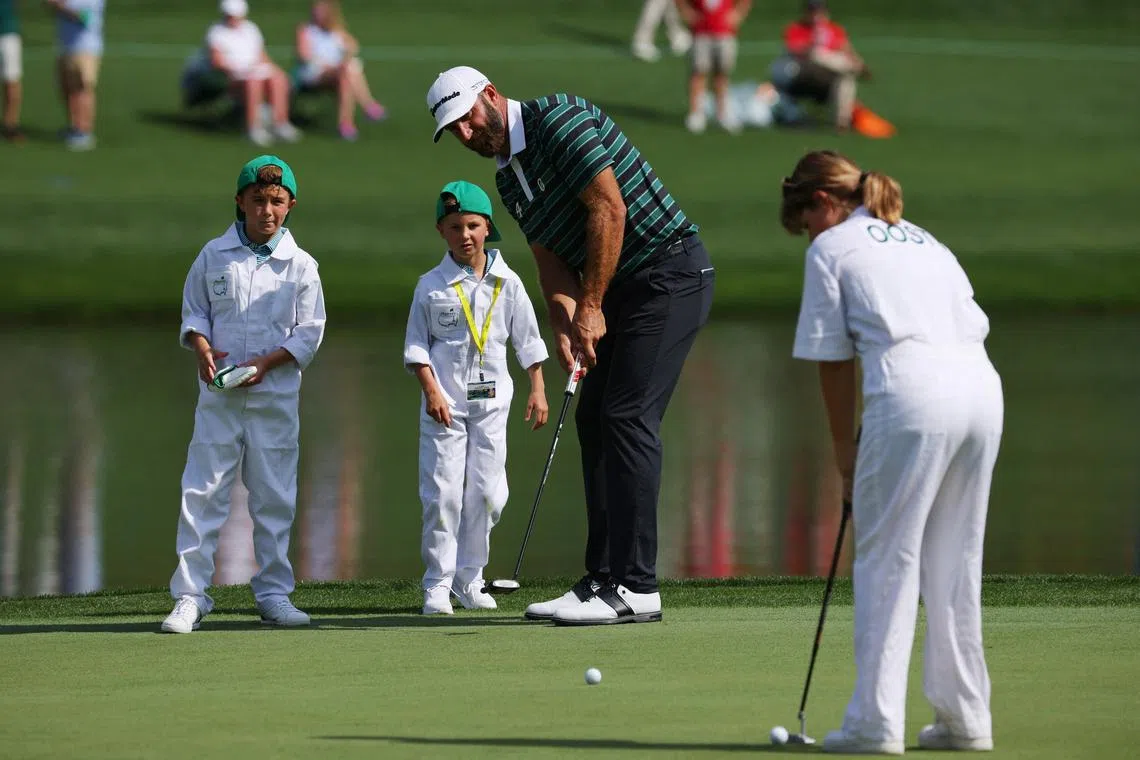The inner world of LIV Golf: Piecing together Saudi-backed tour’s power structure
Sign up now: Get the biggest sports news in your inbox

Dustin Johnson with his children Tatum and River on the third hole green during the par-3 contest at the Masters. He has won at least US$35 million on the LIV Golf tour.
PHOTO: REUTERS
Follow topic:
AUGUSTA – LIV Golf has cleaved men’s professional golf like no other force since the 1960s.
The new league, largely owned and bankrolled by Saudi Arabia’s sovereign wealth fund, created a crisis for the PGA Tour, which has scrambled to reinvent its economic model as it has watched some of its biggest stars switch circuits. But LIV has also been a target of fierce criticism, skepticism and litigation. Although much about the circuit’s operations remains unclear – many documents that would reveal details are under court seal – some information about its structure and its operations has emerged in legal filings, interviews, business records and internal documents reviewed by The New York Times.
Some of the world’s top players, including Dustin Johnson and Phil Mickelson, have become the faces of LIV Golf. But the enterprise has been made possible by a web of investors, fixers, and political allies and patrons from around the world, including a former United States president and the crown prince of Saudi Arabia.
One of the world’s largest sovereign wealth funds, Saudi Arabia’s Public Investment Fund, has been central to Crown Prince Mohammed bin Salman’s plan to diversify the kingdom’s economy and make it a greater global player. Sports investments, including LIV and Premier League team Newcastle United,
The wealth fund’s lawyers have depicted it as a mere investor in LIV, but in a ruling in February, a US judge said she believed the fund was “the moving force behind the founding, funding, oversight and operation of LIV.” The PGA Tour has asserted in court that the wealth fund effectively owns 93 per cent of the golf league and contends, as do other LIV critics, that the wealth fund is using sports to distract from Saudi Arabia’s record of human rights abuses.
The circuit’s 54-hole, no-cut events have offered fans a condensed, less starchy product than the PGA Tour and its contemporaries. But the league has suffered from turnover – its chief operating officer, who was regarded as vital to LIV realising its business ambitions, is among the executives who have left in recent months. And it has struggled to break through, especially in the US.
Performance54, a golf marketing agency based in Britain run by Gary Davidson and a handful of others who have been involved in LIV since its conception, has played a significant recent role in the league given the executive turnover. Court records show it effectively has a minority ownership stake in LIV.
LIV has blamed the PGA Tour for its troubles. a television deal with the CW Network,
White-shoe law firm Gibson, Dunn & Crutcher has been central to LIV’s legal case, which will not go to trial until at least next year. LIV has also brought in powerful figures in Republican politics to help. Ari Fleischer, a White House spokesperson under President George W. Bush, moderated a heated LIV news conference and has advised the league on its communications strategy. Benjamin Quayle, a former congressman and a son of former Vice-President Dan Quayle, has registered as a lobbyist for LIV.
Many of LIV’s players are little known. But the league’s 48-player roster still boasts men who are, or were, some of golf’s biggest names. Cameron Smith, who is No. 6 in the Official World Golf Ranking,
Some players received contracts that reportedly guaranteed them at least US$100 million (S$133 million) each, and LIV has committed to paying US$405 million in prize money across 14 events this season. Last year, Johnson earned at least US$35 million – he recorded about US$75 million in similar earnings during 15 PGA Tour seasons.
Former president Donald Trump has been a public cheerleader for LIV,

